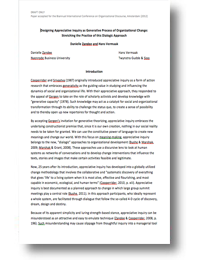Designing Appreciative Inquiry as a Generative Change Process
Stretching the Practice of this Dialogic Approach
Because of its apparent simplicity and luring strength-based stance, appreciative inquiry can be misunderstood as an attractive and easy to emulate technique. Such misunderstanding may cause slippage from thoughtful inquiry into a managerial tool to create motivational experiences at work rather than to engage with complex issues. Such slippage may ultimately turn the appreciative approach into another disappointing management fad. Fortunately, the prolific use of appreciative inquiry during the last decades provides us with rich experiential material for timely reflection, critique and renewal.
Cooperrider and Srivastva originally introduced appreciative inquiry as a form of action research that embraces generativity as the guiding value in studying and influencing the dynamics of social and organizational life. Now, 25 years after its introduction, appreciative inquiry has developed into a globally utilized change methodology that involves the collaborative discovery of everything that gives ‘life’ to a living system. Appreciative inquiry is best documented as a planned approach to change in which large group summit meetings play a central role. In this approach participants, who ideally represent a whole system, are facilitated through dialogue that follow the so-called 4-D cycle of discovery, dream, design and destiny. However, in practice many contrasting and hybrid designs of AI processes can be witnessed but these are much less documented in literature.
The diversification of appreciative inquiry applications is a sign of its increasing maturity. With this rising popularity comes the challenge to uphold its robust conceptual grounding and to promote its practical finesse. How can we further develop appreciative inquiry as a fruitful interplay between principles, change designs and facilitation? We believe that a common language for contingent change design, with the vocabulary of design choices and indicators, may help. Change agents who use appreciative inquiry, should thoughtfully consider how to best work with it in a specific context at a specific time. Ideally such consideration includes possibilities, challenges and risks next to their own facilitation abilities and the appropriateness of alternative change practices.
In this paper we try to provide such a common language for situated AI design. We delineate three main dimensions for this design in terms of how its life-centric focus, its spirit of inquiry and its relational engagement may be put into practice. We use case examples and literature discussions to illustrate how contrasting designs are possible and generative in each of the three dimensions. This involves exploring how the ‘negative’ can be transformative, how inquiry can as much further by research rigor as by a sense of wonder and how exclusion of some stakeholders at the expense of others can be a generative choice.
We also outline three design indicators to assist such design adaptation to each specific case: the choice of affirmative topic, the legitimacy of the change and the existing capacity for change. Here we explore how ‘tough’ issues can be a fertile ground for value creation, how institutional forces may require covert and critical forms of inquiry and how to strike a productive balance between capacity development and research rigor.
With these design dimensions and design indicators we visualize the richness of contingent possibilities in an ‘AI-space’. We propose that the generativity of any appreciative inquiry process depends on a tight coupling between an understanding of its principles, a contingent and fluid change design and a craftful facilitation that brings the design to life. The bridge between principles and change design lies in the judgment what works best given the situation at hand: this is where the ‘AI space’ may be of help. The bridge between change design and craftful facilitation lies in the ability to discern what enables generative change in the here and now and what is needed to make the process ongoing.
In workshops and conferences we notice an increasing number and variety of practical applications that typically pay more attention to the “how” of change facilitation than to the guiding rationale. Best known scholarly publications on the other hand, pay more attention to theoretical underpinnings and a few dominant change designs, but give less detail about the craftful application into practice. We suggest that what the field needs most, are interchanges between both worlds, which can lead to rich descriptions of how contrasting designs can be craftfully facilitated in a way that does justice to appreciative inquiry principles.
We hope our paper reads as an example of such interchange. Since the discourse conference we have been reworking our paper for publication. We have attached the updated version for download.







